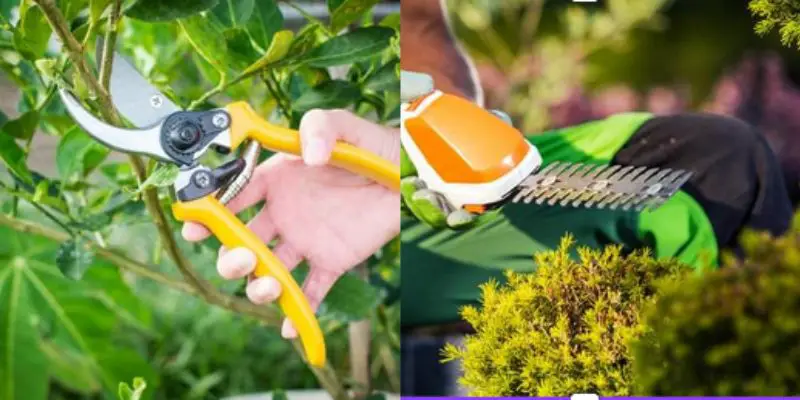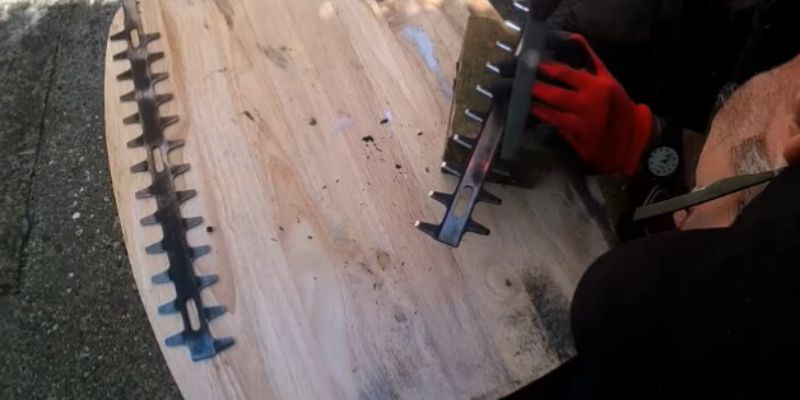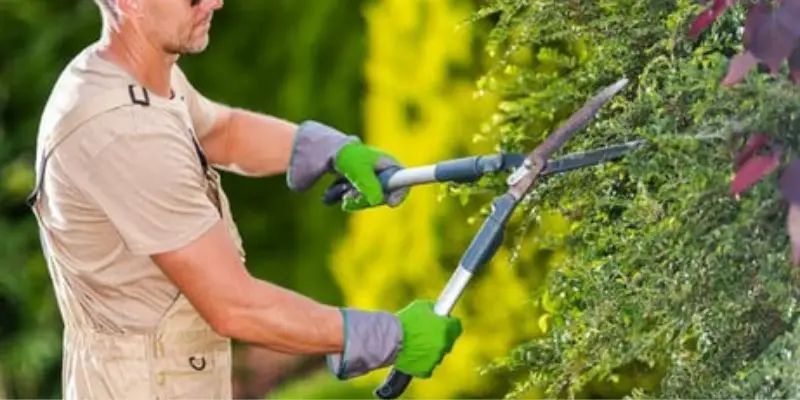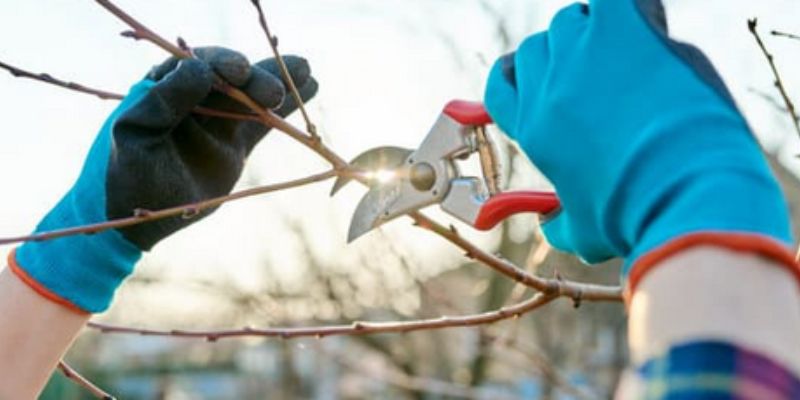I’ve been gardening and doing landscaping work for a long time. For many years, I have taken care of hedges, bushes, and plants. I have tried lots of different tools to cut leaves and branches. I learned from my mistakes which tools work best for each job.
Shears and hedge trimmers look similar but they are different tools for specific cutting jobs. In this guide, I will tell you about using shears vs hedge trimmers so you know the difference and can pick the right one. Knowing the difference can save you time and give you cleaner, more accurate cuts.
What are Shears?
Let’s start with shears. They are important for detailed cutting work. Shears are also called hedge shears or garden shears. They have long handles with two sharp blades that meet in the middle like scissors to cut leaves.
The cutting blades on shears are usually between 4-8 inches long. They move like scissors for precise cuts. Good shears have blades you can replace and sharpen so they stay very sharp. The handles are longer than hedge trimmers, from 12-24 inches long. This lets you cut higher parts of plants.
In my experience, shears excel at trimming fine details, shaping individual branches, and accessing tight spaces. Their lightweight and long handles make them easy to control down to a fraction of an inch. Here are some of the main tasks shears handle best:
- Deadheading flowers – Shears are perfect for snipping off spent blooms without damaging surrounding flower buds.
- Leaf and flower stem pruning – Their sharp blades cut cleanly through thin stalks without tearing.
- Shaping hedges – Shears allow following intricate shapes and patterns freehand without bulky machinery getting in the way.
- Trimming around obstacles – Their long reach helps trim up against fences, walls, and other landscape features with precision.
- Detail work – Shears enable clipping individual twigs and branches to creative shapes or remove selected growth from foundation shrubs.
The downside is that repeated shearing of large areas can be time-consuming work for the hands and arms. While tiring for major pruning jobs, I couldn’t live without shears for their unmatched control. With the right technique, they yield beautiful results.
What are Hedge Trimmers?
In contrast to shears, hedge trimmers (also called hedge clippers) are a cordless or electric tool designed for quicker trimming of larger masses of foliage like hedges, shrubs, and small trees. Their cutting blades run parallel rather than meeting at the center, allowing them to remove branches in a pulling motion rather than requiring scissor-like fingers.
Best Cordless Battery Hedge Trimmers: 7 Expert-Approved Picks
Most hedge trimmers have 6-10 inch long semi-circular cutting blades powered by either rechargeable battery packs or corded electric motors. Lighter-duty versions may have plastic housing while professional models feature all-metal construction for durability. Hedge trimmers range in cutting capacity from 1/4 to 3/4 inches in diameter depending on the model.
In my experience, hedge trimmers excel at bulk pruning tasks too time-consuming for shears. With their ergonomic handles designed for one-handed operation, I can cut continuously for hours without fatigue. This makes them ideal for:
- Routine hedge maintenance – They zip through repetitive trimming of square or rounded hedges in a fraction of the time shears would take.
- Shrub rejuvenation – You can strip entire shrubs back to stubs fast to encourage fuller regrowth from the base later.
- Topping trees – Tall branches that would be out of reach with shears pose no problem for longer-handled trimmers.
- Overgrown areas – Hedge trimmers make short work of battle-axing out-of-control growth back to a manageable shape and size.
- Large jobs – Whether a half-acre of forsythia or a mile of suburban shrubbery borders, trimmers scale to any volume of pruning.
Their downside for me is a lack of precision compared to shears. Trimmers leave a blunter cut and may remove slightly more foliage than desired for tight detailing. And corded models limit your range of motion with a trailing power cord.
Despite these minor quibbles, I couldn’t farm my acres of landscaping without my trusty hedge trimmers. For any job too big, high, or tiring for shears, they are indispensable long-term work partners.
Key Differences between Shears and Hedge Trimmers
Now that you have an idea of the intended uses and strengths of shears vs hedge trimmers from my professional perspective, let’s summarize some of the core differences between pruning shears and hedge trimmers:
- Blades – Shears have crossed scissor-like blades while trimmers cut using parallel sliding blades.
- Cutting motion – Shears cut with squeezing hand motions versus the pulling action of trimmers.
- Cut precision – Shears offer more exact snipping control down to a 1/16th inch edge versus a blunter 1/4-3/4 inch trim on hedges with trimmers.
- Reach – Shears have longer 12-24 inch handles for detailed high and low work vs 6-10 inches on trimmers.
- Operating comfort – Shears tire hands faster but trimmers let you comfortably cut bulk volumes for hours.
- Power source – Shears require hand power alone while trimmers may be corded or cordless battery models.
- Maintenance – Shears need blade sharpening but trimmers may only require occasional lubrication of moving parts.
- Trimming capacity – Shears handle detail work on anything 1/4 inch or less, and trimmers efficiently cut anything 1/4-3/4 inches.
- Price range – Quality shears cost 20-100 while trimmers run 30-300 depending on features and motor/battery power.
Given these key differences summarized from decades of experience, I advise using shears for sculpting, deadheading, and tight shaping work on branches 1/4 inch or less. Choose trimmers when tackling larger areas or branches from 1/4-3/4 inches needing faster volume pruning. Both tools have unique benefits but understanding their specialized functions will save you time and stress.
Caring for Your Tools Properly
No matter which pruning tools you rely on for your landscaping tasks, taking good care of them is important to ensure longevity and peak performance season after season. Here are some best practices I’ve learned over the years:
- Clean and dry blades after each use to prevent rusting. Wipe down the entire tool.
- Lightly oil all moving parts of trimmers per the user manual to keep parts sliding smoothly.
- Sharpen blades regularly for shears – at least 3-4 times a year if used heavily. I send mine to a professional sharpener.
- Store shears and trimmers indoors in a cool, dry place when not in season to prevent weather damage.
- Periodically check blades for dullness or breaks – replace when needed for safety.
- Tighten any screws or bolts that may have loosened over time from vibration.
- Charge trimmers fully before putting them away for winter to keep batteries in good condition.
- Consider oiling or greasing all metal parts of shears and trimmers annually even for minimal/lightly used tools.
- Watch out for and promptly replace any damaged parts like cracked handles or housing that could compromise tool integrity.
Following diligent care habits has helped me keep my professional tools operating buttery smooth for more than 15-20 years, saving me money compared to replacing worn-out items prematurely. I’ve found happy tools make for a happy gardener!
Preventing Accidents and Staying Safe
When using any kind of power tool like hedge trimmers, safety should always be the top priority. Even hand shears require caution to avoid accidentally cutting oneself while working. Over the years, I’ve learned these important habits to prevent injuries when trimming:
- Always wear eye protection like safety glasses to guard against getting debris or clippings accidentally flicked into your eyes.
- Ear protection goes on too for loud corded trimmers to reduce noise exposure over long periods.
- Opt for high-quality non-slip gloves to protect hands from nicks and maintain grip, especially when surfaces are wet.
- Do a safety check for loose fittings or cracked housings before each use and dispose of tools with defects immediately.
- Avoid loose clothing and jewelry that could get tangled in moving parts when operating trimmers.
- Keep tools sharpened and carefully controlled to minimize kickbacks from tangled material.
- Create clear zones around you – never let anyone enter your work area when trimmed clippings are flying.
- Cordless trimmers pose less risk than struggling with cords that strain your reach or trip others.
- Take frequent breaks when pruning for prolonged periods to avoid muscle fatigue leading to slips.
Staying Focused on Precision with Practice
No matter which pruning tools you rely on, developing sharp skills through practice over time is key to getting professional-level results. Both shears and hedge trimmers require learning subtle techniques to smoothly glide blades through plant material for an attractive cut. Here are some tips I’ve picked up on maintaining focus:
- With shears, don’t bear down too hard which can bruise foliage – use gentle finger pressure. Let sharp blades do the work.
- Pull shears through each cut with a single smooth motion rather than repeatedly snipping at branches.
- For shears and trimmers, angle blades 30-45 degrees away from new growth when pruning to encourage density rather than creating bald spots.
- Work from the bottom up when shaping large areas to prevent raining debris onto freshly cut sections below.
- Take your time for perfection rather than rushing – it’s worth the extra few minutes now for months of better results later.
- Practicing on individual plant cuttings or branches first lets you get “IN THE ZONE” without stressing over a full formal hedge.
- Mark guidelines for complex patterns with twine before trimming to easily envision the finished product.
- Periodically step back regularly to inspect your work with a critical fresh eye and make minor adjustments.
- Consider hiring a professional occasionally to mimic their techniques and learn shortcuts for efficiency.
I’ve realized skills like maintaining an even cutting angle or consistent branch spacing only sharpen after hundreds of hours of use. Don’t get discouraged if results aren’t perfect initially – stick with it and you’ll be an expert in no time. Precision comes with practice!
Common Maintenance Schedules
Depending on your specific plant varieties and regional climate conditions, most hedges and shrubs require pruning either once, twice, or more per growing season for ideal shape and performance. Let’s look at some common generalized maintenance schedules:
- Spring-flowering shrubs like lilacs – Trim spent blooms shortly after flowering, then give more structural pruning in late winter or very early spring before new growth emerges.
- Summer-flowering shrubs like hydrangeas – Wait until just after blooming finishes to do light tidying and pinching of extensions. Minor pruning in very late winter/early spring.
- Broad-leaved evergreens like boxwood – Mild clipping as needed throughout the growing season primarily for shape maintenance. Major structural pruning every 2-3 years very early spring.
- Fast-growing hedges like arborvitae – Trim monthly during growing periods to retain a uniform appearance. Major shear 2x annually in spring and summer.
- Slow-growing hedges like yew – Minimal shaping 1x per year in late winter. Let them retain a semi-natural irregular shape between prunings.
- Privacy/screening hedges – Maintain a consistent height with monthly clipping during peak growth periods. Prune to a suitable width 1-2x yearly.
Adjust schedules as needed for your climate and individual plant vigor. Consistency is key to avoiding over/under-trimming and stressing plants with imbalance. With practice, harmonizing pruning and foliage times becomes second nature.
7 Best Top Rated Electric Hedge Trimmers – A Detailed Buying Guide
In Conclusion
I’ve been gardening for many years now, so I’ve learned what tools work best. Shears and hedge trimmers look alike but are good for different pruning tasks. It’s important to know the difference.
I use shears all the time when cutting hedges and plants. They let me shape things neatly with their sharp blades. Shears are perfect for small detailing around flowers and vines too. The long handles help me reach high parts. After a while the blades get dull and I need to replace or sharpen them.
When I have a lot of thick branches to cut, my electric hedge trimmer saves me work. It slices right through thick leaves with no effort. With shears, I get tired faster. Just be aware trimmers aren’t as good as shears for small cuts.
Now that I’ve gardened so long, I know to use shears for details and trimmers for bulk cutting. Taking time to learn tools pays off. It helps do a great job while saving your energy too! Always picking the right tool makes gardening way easier.

Michael has been in the landscaping world for over 15 years. After obtaining his arborist certification, he dedicated himself to sharing his immense knowledge about plants, trees, and their proper care. Pruning is Michael’s passion. He’s spent decades mastering techniques for timing, methods, and tools. Michael takes great joy in ensuring others learn to maintain beautiful, healthy gardens, and landscapes. Whether through guides, tutorials, or advice, his goal is to equip homeowners and professionals with pruning expertise.
When it comes to choosing the right equipment, Michael is also incredibly knowledgeable. He has used countless pruning tools to discover the most durable, high-quality options. Michael understands what works best in the field. His in-depth comparisons will save you time and money by finding the perfect shears, loppers, trimmers, or saws.
With great respect for horticulture and sustainability, Michael is committed to educating communities. By sharing the insights gained over a lifetime around greenery, he empowers people to steward the planet’s verdant spaces responsibly. Nature is his true passion, and Michael aims to foster others’ love of the living world through his writings.





